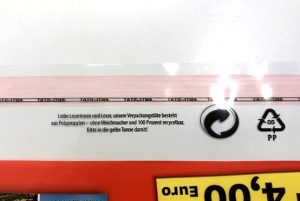There has been increasing concern in recent years for the negative impact of plastic packaging on the Mother Earth. This article explains the issues associated with foil packaging and suggests how to select the optimal eco-friendly packaging solution.
Are plastics synthetic?

Contrary to the commonly used name, “synthetics” are of natural origins. They are produced using synthesized organic raw materials, such as coal, cellulose, natural gas or crude oil. Plastics such as polypropylene or polyethylene are used in order to obtain foil to produce foil bags. These synthetics in their raw form come as granules, which after heating to a sufficiently high temperature take a liquid form. It then becomes possible to produce a uniform material using them.
What foil is used to make magazine bags?

OPP foil is highly transparent, glossy and elegant. Anything can be printed on it. It is the most popular foil for producing magazine bags. It can also be used as laminate, e.g., with metallized OPP foil, in order to draw attention or emphasize the prestige of a given journal. Therefore, it enables obtaining e.g., the golden colour effect in an easy and relatively inexpensive way.
CAST (CPP) foil is characterized by high gloss and transparency. Its low specific weight impacts the packaging efficiency relative to other foils with the same thickness. Owing to the high tear/puncture resistance, it is easily perforated. This foil is often used when a newspaper bonus comes with edges, irregular shape etc.
LDPE is a polyethylene foil that is perfect for every type of goods. Often used when packing industrial, chemical, as well as food products. It is very durable and can be used both for manual and automatic packing. It can be overprinted. It is less commonly used for manufacturing foil bags for publishing houses – due to being less transparent, yet very durable. It is perfect for large mailing campaigns.
PCR or IRis a heterogeneous LDPE-recycling foil and can have impurities. Its price is related to the availability of the recycled raw material, but still always lower than OPP or LDPE foils. It can be printed over. What is important is that PCR and IR foils can be further recycled and should be disposed of using a yellow waste container. Using these foils can actively support the readers in making an informed choice regarding the purchase of eco-friendly products, hence, creating a better and cleaner living space. At the same time, it can reinforce the image of the publishing house.

PLA foil or polylactide (polylactic acid) is made of renewable plant raw materials, e.g., corn or cane sugar. It is transparent, stiff and brittle. It is not flexible and is easily damaged. Its price is several times higher than that of other foils. PLA foil can be overprinted and come in contact with food products. It is fully biodegradable and can be recycled, but… be sure to read the rest of this article!
How to properly sort and recycle foils?
We believe that one of the most important issues associated with environmental protection is correct segregation of plastics and their recycling! The objective of recycling is to limit the consumption of natural resources and reduce waste! Recycling involves the recovery of raw materials from waste products and their re-use for manufacturing new goods.
Most common recycling products include foils, domestic detergent bottles, containers and canisters, road posts, fences, PVC window frames, fibres (e.g., polyester yarn), heating oils, toys, pens and stationery, furniture, thermo-insulating boards, noise barriers and flower pots.
What is the recycling code??

Materials that are suitable for re-use can be labelled with a recycling code. It is a graphic symbol that contains three arrows forming a triangle. Such information is affixed on packaging that is subject to re-use. The number and text that may come with the symbol mean the type of raw material used to produce a given packaging.
Recycling sign vs green point
These two symbols are often confused. The circle that houses two green arrows is the Green Point. This symbol is not a recycling sign but informs that the manufacturer of the product handled recycling and has paid a specialist company to recover packaging material. Entrepreneurs throughout the world use it willingly and affix it next to the three-arrow symbol. Its presence evidences that a given manufacturer is part of its domestic packaging recovery and recycling system.

Recommended labelling of newspaper packaging
One of the solutions that we recommend is appropriate marking of all packaging (also for magazines), even if it is not required by provisions of the law. Such marking and additional information should assist a consumer in disposing of the packaging using a relevant waste container, so that it is recycled and re-used. Marking with appropriate comments should be affixed on the flap closing the bag
For example: “This bag is made of polypropylene, which is 100% recyclable. It should be disposed of to a yellow waste container, so that it can be processed, e.g., into a playground, toy bucket or pen.” or “Dear Reader – the packaging for this issue is made of 100% recyclable polypropylene. Throw it out to a yellow container, to give it a second life!”
Our mission, together with the publishing houses, is to educate readers in the field of the segregation and recycling of plastics.

What does the symbol of a person throwing out trash mean?
A graphic symbol showing a person throwing out trash to a waste bin means Keep it Clean. It most usually appears next to the recycling symbol. This icon calls for throwing out packaging directly after consuming its contents. “Keep it clean” appeals to not litter the natural environment, hence, care for one’s surroundings. It is often accompanied by a symbol asking to crush the packaging prior to throwing it out.
What is Greenwashing?
Greenwashing is using “pro-ecological” phrases like “environmentally friendly”, “eco-friendly”, “Earth-friendly”, “non-polluting”, “green”, “friend of nature” and “ozone-layer friendly”. Such statements are imprecise, unclear and may even be misleading!
An eco-packaging is a fashionable slogan and trend that is often used inappropriately and imprecisely. For purely commercial purposes, some companies affix their packaging with labels that use themes evoking pro-environmental associations and sometimes false signs or texts that quite obviously impact the subconsciousness of the customers
Are bio-compostable foils really eco-friendly?
Due to the growing demand for eco-solutions, more and more foils are appearing that meet market trends, such as sustainable development and environmental protection technologies. Such foils include PCR and PLA foils referred to above. Biodegradable (PLA) foils decompose solely under industrial composting conditions, which require appropriate amount of light, humidity, oxygen supply and temperature.
Polish composting plants are not ready for biodegradable PLA packaging, since they are primarily focused on biowaste, such as leaves or mowed grass. Therefore, the likelihood of a sorting plant forwarding biodegradable waste to an industrial composting plant is currently very low. In practice, PLA can be incinerated as alternative fuel. PLA foil packaging (that optically resembles standard plastic foils) accidentally disposed of into a yellow container contaminates conventional plastic that could be recycled later.
Therefore, bio-foils are not as eco-friendly, as you could think…
All-in on recycling!
Every year, we use over 300 million tons of plastic products worldwide. Landfills receive 280 million tons of plastic waste, of which only a small portion – approx. 9% is recovered and recycled. A large amount of used plastic goes to incinerating plants, which generates hazardous substances released to the air we breathe. These poisonous gases affect people, plants and animals! A lot of plastic wastes end up in landfills or seas and oceans.
Therefore, if you have to use plastic, it must be absolutely recycled!



